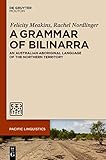A grammar of Bilinarra : an Australian aboriginal language of the Northern Territory / Felicity Meakins, Rachel Nordlinger.
Material type: TextSeries: Pacific linguistics ; 640.Publisher: Boston ; Berlin : De Gruyter Mouton, [2014]Copyright date: ©2014Description: 1 online resource (558 pages) : mapsContent type:
TextSeries: Pacific linguistics ; 640.Publisher: Boston ; Berlin : De Gruyter Mouton, [2014]Copyright date: ©2014Description: 1 online resource (558 pages) : mapsContent type: - text
- computer
- online resource
- 9781614512745
- 1614512744
- 161451268X
- 9781614512684
- 499/.15 23
- PL7101.N97 M43 2014eb
| Item type | Home library | Collection | Call number | Materials specified | Status | Date due | Barcode | |
|---|---|---|---|---|---|---|---|---|
 Electronic-Books
Electronic-Books
|
OPJGU Sonepat- Campus | E-Books EBSCO | Available |
Includes bibliographical references and index.
This volume provides the first comprehensive description of Bilinarra, a Pama-Nyungan language of the Victoria River District of the Northern Territory (Australia). Bilinarra is a highly endangered language with only one speaker remaining in 2012 and no child learners. The materials on which this grammatical description is based were collected by the authors over a 20 year period from the last first-language speakers of the language, most of whom have since passed away. Bilinarra is a member of the Ngumpin subgroup of Pama-Nyungan which forms a part of the Ngumpin-Yapa family, which also includes Warlpiri. It is non-configurational, with nominals commonly omitted, arguments cross-referenced by pronominal clitics and word order grammatically free and largely determined by information structure. In this grammatical description much attention is paid to its morphosyntax, including case morphology, the pronominal clitic system and complex predicates. A particular strength of the volume is the provision of sound files for example sentences, allowing the reader access to the language itself.
Print version record.
Preface; Acknowledgements; List of tables; List of figures; List of abbreviations; Conventions used in transcription and glossing; Conventions used to indicate source of data; Recording metadata; Map; 1 The language and its speakers; 1.1 Introduction; 1.2 The language; 1.2.1 Previous work, sources and methodology; 1.2.2 Bilinarra in relation to Gurindji and Ngarinyman; 1.3 The socio-political and linguistic history of the Bilinarra people; 1.3.1 Pre-contact history and the language situation; 1.3.2 The European invasion and its effect on the language ecology.
1.3.3 Life and language on the cattle stations1.3.4 Bilinarra life and culture today; 1.3.5 Bilinarra and its language ecology today; 1.4 Kinship; 1.5 Mother-in-law speech; 2 Phonology; 2.1 Phoneme inventory; 2.1.1 Practical orthography; 2.1.2 Phonemic oppositions; 2.1.2.1 Consonants; 2.1.2.1.1 Place of articulation contrasts; 2.1.2.1.2 Manner of articulation contrasts; 2.1.2.2 Vowels; 2.1.2.2.1 Height; 2.1.2.2.2 Backness; 2.1.2.2.3 Length; 2.1.2.3 Alternation between phonemes /j, ny/; /d, n/; 2.1.3 Allophony; 2.1.3.1 Stops and voicing; 2.1.3.2 Vowels; 2.1.3.2.1 Allophones of /a.
2.1.3.2.2 Allophones of /i/2.1.3.2.3 Allophones of /u/; 2.2 Phonotactics; 2.2.1 Syllable structure; 2.2.2 Stem syllabicity; 2.2.3 Stem-initial position; 2.2.4 Stem-final position; 2.2.5 Consonant clusters; 2.2.5.1 Intra-morphemic consonant clusters; 2.2.5.2 Inter-morphemic consonant clusters; 2.2.6 Stress; 2.3 Phonological rules; 2.3.1 Stop-glide lenition; 2.3.1.1 /g/> /w/; 2.3.1.2 /b/> /w/; 2.3.1.3 /j/> /y/; 2.3.2 Glide deletion; 2.3.3 Vowel assimilation; 2.3.4 Nasal cluster dissimilation (NCD) deletion; 2.3.5 Epenthesis; 2.3.6 Reduplication; 3 Parts of speech; 3.1 Introduction.
3.2 Nominals3.2.1 Nouns; 3.2.2 Adjectives; 3.2.3 Directionals; 3.2.4 Temporals; 3.2.5 Free pronouns; 3.2.6 Demonstratives; 3.2.7 Interrogatives; 3.3 Bound pronouns; 3.4 Inflecting verbs; 3.5 Coverbs; 3.6 Adverbs; 3.7 Clitics; 3.8 Complementizers; 3.9 Particles; 3.10 Interjections; 4 Nominals 1: Nouns, case, adnominal and derivational morphology; 4.1 Word structure; 4.2 NP structure; 4.2.1 Properties of NPs; 4.2.2 Functions of nominals within the NP; 4.2.2.1 Heads; 4.2.2.2 Modifiers; 4.3 Case morphology; 4.3.1 Nominative and accusative; 4.3.2 Ergative; 4.3.2.1 Form; 4.3.2.2 Function.
4.3.3 Locative4.3.3.1 Form; 4.3.3.2 Function; 4.3.4 Dative; 4.3.4.1 Form; 4.3.4.2 Function; 4.3.5 Allative; 4.3.5.1 Form; 4.3.5.2 Function; 4.3.6 Ablative; 4.3.7 Source; 4.3.8 Perlative; 4.3.9 Terminative; 4.4 Other nominal morphology; 4.4.1 Number; 4.4.1.1 -Ï SINGULAR/GENERAL; 4.4.1.2 -gujarra DUal; 4.4.1.3 -jban PLural; 4.4.1.4 -walija PAUCal; 4.4.1.5 -burruburru AND, ALSO, TOO; 4.4.1.6 -nganyju GROUP; 4.4.1.7 -warlug FIRST; 4.4.1.8 -wurd TIME; 4.4.1.9 Reduplication; 4.4.2 Adnominal suffixes; 4.4.2.1 -jawung PROPrietive; 4.4.2.2 -murlung PRIVative; 4.4.3 Derivational Suffixes.
eBooks on EBSCOhost EBSCO eBook Subscription Academic Collection - Worldwide
There are no comments on this title.

